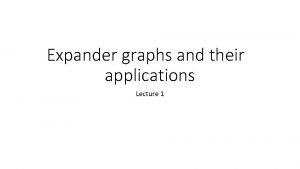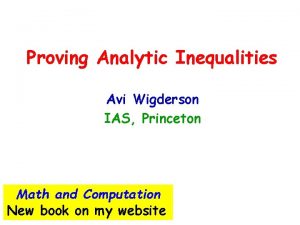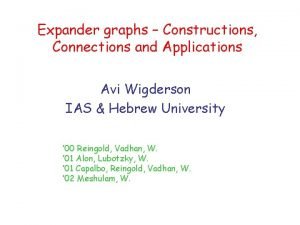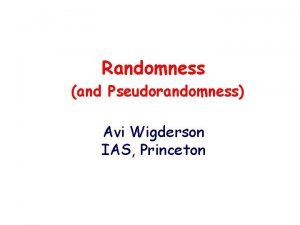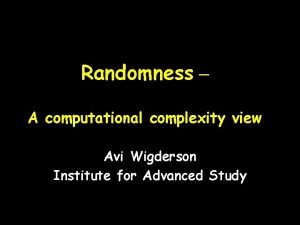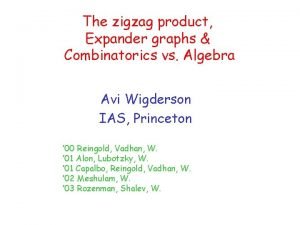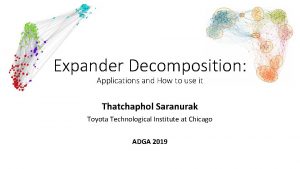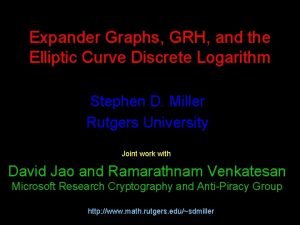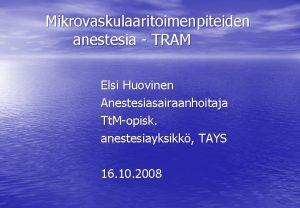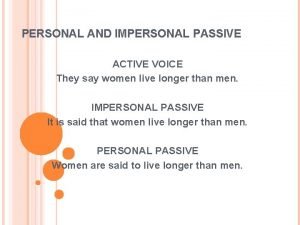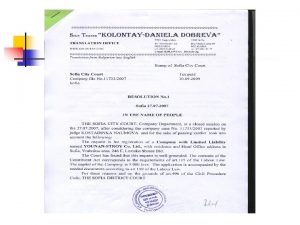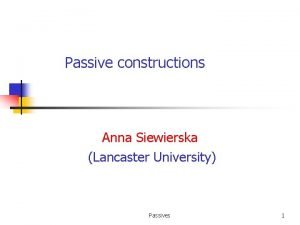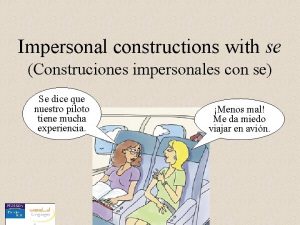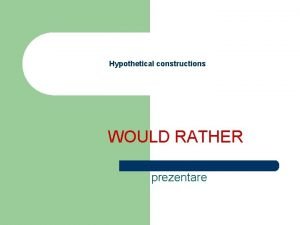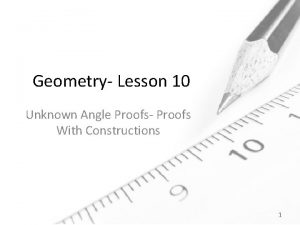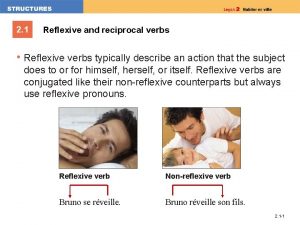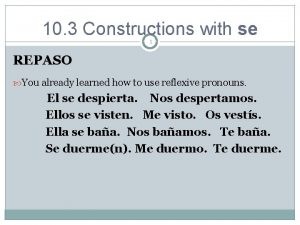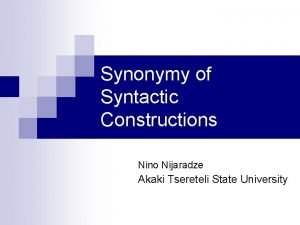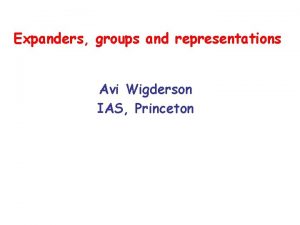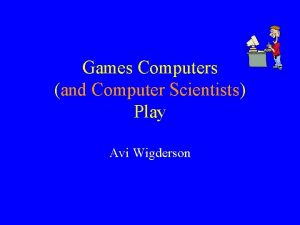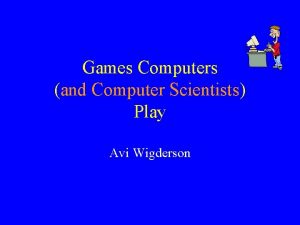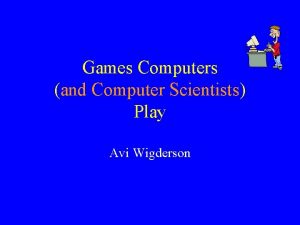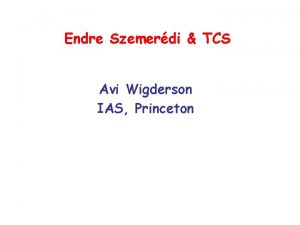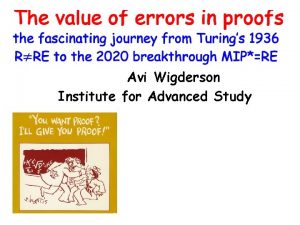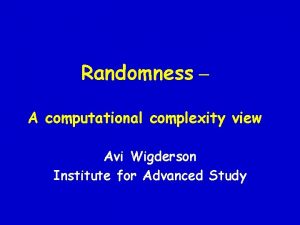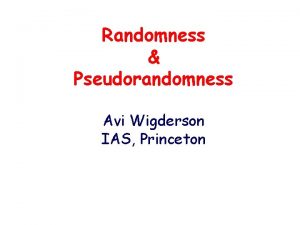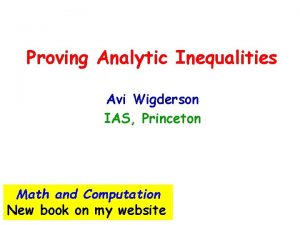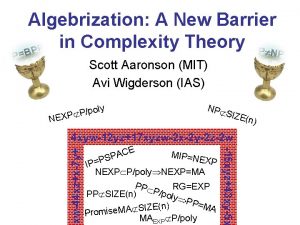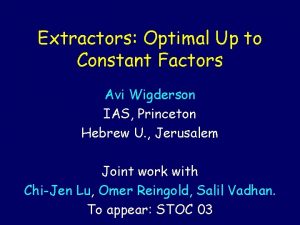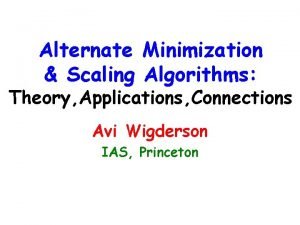Expander graphs Constructions Connections and Applications Avi Wigderson




![Applications of Expanders In Pure Math • Topology – expanding manifolds [Br, G] • Applications of Expanders In Pure Math • Topology – expanding manifolds [Br, G] •](https://slidetodoc.com/presentation_image_h/f168c423f684f60de49ed13d1a55e96e/image-5.jpg)
![Deterministic amplification G [2 n, d, 1/8]-graph G explicit! {0, 1} Bx random strings Deterministic amplification G [2 n, d, 1/8]-graph G explicit! {0, 1} Bx random strings](https://slidetodoc.com/presentation_image_h/f168c423f684f60de49ed13d1a55e96e/image-6.jpg)
![Algebraic explicit constructions [M, GG, AM, LPS, L, …] Many such constructions are Cayley Algebraic explicit constructions [M, GG, AM, LPS, L, …] Many such constructions are Cayley](https://slidetodoc.com/presentation_image_h/f168c423f684f60de49ed13d1a55e96e/image-7.jpg)

![Explicit Constructions (Combinatorial) -Zigzag Product [RVW] G an [n, m, ]-graph. H an [m, Explicit Constructions (Combinatorial) -Zigzag Product [RVW] G an [n, m, ]-graph. H an [m,](https://slidetodoc.com/presentation_image_h/f168c423f684f60de49ed13d1a55e96e/image-9.jpg)
![Example G=B 2 m, the Boolean m-dim cube ([2 m, m]-graph). H=Cm , the Example G=B 2 m, the Boolean m-dim cube ([2 m, m]-graph). H=Cm , the](https://slidetodoc.com/presentation_image_h/f168c423f684f60de49ed13d1a55e96e/image-10.jpg)
![Iterative Construction of Expanders A stronger product z’ : G an [n, m, ]-graph. Iterative Construction of Expanders A stronger product z’ : G an [n, m, ]-graph.](https://slidetodoc.com/presentation_image_h/f168c423f684f60de49ed13d1a55e96e/image-11.jpg)
![Beating e-value expansion [WZ, RVW] In the following a is a large constant. Task: Beating e-value expansion [WZ, RVW] In the following a is a large constant. Task:](https://slidetodoc.com/presentation_image_h/f168c423f684f60de49ed13d1a55e96e/image-12.jpg)
![Lossless expanders [CRVW] Task: Construct an [n, d]-graph in which every set of size Lossless expanders [CRVW] Task: Construct an [n, d]-graph in which every set of size](https://slidetodoc.com/presentation_image_h/f168c423f684f60de49ed13d1a55e96e/image-13.jpg)
![Error Correcting Codes [Shannon, Hamming] C: {0, 1}k {0, 1}n Rate (C) = k/n Error Correcting Codes [Shannon, Hamming] C: {0, 1}k {0, 1}n Rate (C) = k/n](https://slidetodoc.com/presentation_image_h/f168c423f684f60de49ed13d1a55e96e/image-14.jpg)
![Decoding Thm [CRVW] Can explicitly construct graphs: k=n/2, bottom deg = 10, B [n], Decoding Thm [CRVW] Can explicitly construct graphs: k=n/2, bottom deg = 10, B [n],](https://slidetodoc.com/presentation_image_h/f168c423f684f60de49ed13d1a55e96e/image-15.jpg)
![Distributed routing [Sh, PY, Up, ALM, …] n inputs, n outputs, many disjoint paths Distributed routing [Sh, PY, Up, ALM, …] n inputs, n outputs, many disjoint paths](https://slidetodoc.com/presentation_image_h/f168c423f684f60de49ed13d1a55e96e/image-16.jpg)




![Dimensions of Representations in Expanding Groups [MW] G naturally acts on Fq. G (|G|, Dimensions of Representations in Expanding Groups [MW] G naturally acts on Fq. G (|G|,](https://slidetodoc.com/presentation_image_h/f168c423f684f60de49ed13d1a55e96e/image-21.jpg)



- Slides: 24

Expander graphs – Constructions, Connections and Applications Avi Wigderson IAS & Hebrew University ’ 00 Reingold, Vadhan, W. ’ 01 Alon, Lubotzky, W. ’ 01 Capalbo, Reingold, Vadhan, W. ’ 02 Meshulam, W.

Expanding Graphs - Properties • Combinatorial: no small cuts, high connectivity • Probabilistic: rapid convergence of random walk • Algebraic: small second eigenvalue Theorem. [C, T, AM, A, JS] All properties are equivalent!

Expanders - Definition Undirected, regular (multi)graphs. Definition. The 2 nd eigenvalue of a d-regular G (G) = max { || (AG /d) v || : ||v||=1 , v 1 } (G) [0, 1] Definition. {Gi} is an expander family if (Gi) <1 Theorem [P] Most 3 -regular graphs are expanders. Challenge: Explicit (small degree) expanders! G is [n, d]-graph: n vertices, d-regular G is [n, d, ]-graph: (G) .

Applications of Expanders In CS • Derandomization • Circuit Complexity • Error Correcting Codes • Communication Networks • Approximate Counting • Computational Information • Data Structures • …
![Applications of Expanders In Pure Math Topology expanding manifolds Br G Applications of Expanders In Pure Math • Topology – expanding manifolds [Br, G] •](https://slidetodoc.com/presentation_image_h/f168c423f684f60de49ed13d1a55e96e/image-5.jpg)
Applications of Expanders In Pure Math • Topology – expanding manifolds [Br, G] • Group Theory – generating random gp elements [Ba, LP] • Measure Theory – Ruziewicz Problem [D, LPS], F-spaces [KR] • Number Theory – Thin Sets [AIKPS] • Graph Theory - … • …
![Deterministic amplification G 2 n d 18graph G explicit 0 1 Bx random strings Deterministic amplification G [2 n, d, 1/8]-graph G explicit! {0, 1} Bx random strings](https://slidetodoc.com/presentation_image_h/f168c423f684f60de49ed13d1a55e96e/image-6.jpg)
Deterministic amplification G [2 n, d, 1/8]-graph G explicit! {0, 1} Bx random strings Pr[error] < 1/3 r 1 x Alg rk r x n Alg x Alg Majority Thm [Chernoff] r 1 r 2…. rk independent (kn random bits) Thm [AKS] r 1 r 2…. rk random path (n+ O(k) random bits) then Pr[error] = Pr[|{r 1 r 2…. rk } Bx}| > k/2] < exp(-k)
![Algebraic explicit constructions M GG AM LPS L Many such constructions are Cayley Algebraic explicit constructions [M, GG, AM, LPS, L, …] Many such constructions are Cayley](https://slidetodoc.com/presentation_image_h/f168c423f684f60de49ed13d1a55e96e/image-7.jpg)
Algebraic explicit constructions [M, GG, AM, LPS, L, …] Many such constructions are Cayley graphs. A a finite group, S a set of generators. Def. C(A, S) has vertices A and edges (a, as) for all a A, s S S-1. A = SL 2(p) : group 2 x 2 matrices of det 1 over Zp. 11 10 S = { M 1 , M 2 } : M 1 = (0 1 ) , M 2 = ( 1 1 ) Theorem. [L] C(A, S) is an expander family. Proof: “The mother group approach”: - Use SL 2(Z) to define a manifold N. - Bound the e-value of (the Laplacian of) N [Sel] - Show that the above graphs “well approximate” N.

Algebraic Constructions (cont. ) Very explicit -- computing neighbourhoods in logspace Gives optimal results Gn family of [n, d]-graphs -- Theorem. [AB] d (Gn) 2 (d-1) --Theorem. [LPS, M] Explicit d (Gn) 2 (d-1) Very general -- works for other groups, eg SLn(p) -- works for other group actions -- works with other generating sets of mother group Basic question [LW]: Is expansion a group property? Is C(Gi, Si) an expander family if C(Gi, Si’) is? Theorem. [ALW] No!!
![Explicit Constructions Combinatorial Zigzag Product RVW G an n m graph H an m Explicit Constructions (Combinatorial) -Zigzag Product [RVW] G an [n, m, ]-graph. H an [m,](https://slidetodoc.com/presentation_image_h/f168c423f684f60de49ed13d1a55e96e/image-9.jpg)
Explicit Constructions (Combinatorial) -Zigzag Product [RVW] G an [n, m, ]-graph. H an [m, d, ]-graph. H Definition. G z H has vertices {(v, k) : v G, k H}. v-cloud v (v, k) Edges u u-cloud in clouds between clouds Theorem. [RVW] G z H is an [nm, d+1, f( , )]-graph, and <1, <1 f( , )<1. G z H is an expander iff G and H are. Combinatorial construction of expanders.
![Example GB 2 m the Boolean mdim cube 2 m mgraph HCm the Example G=B 2 m, the Boolean m-dim cube ([2 m, m]-graph). H=Cm , the](https://slidetodoc.com/presentation_image_h/f168c423f684f60de49ed13d1a55e96e/image-10.jpg)
Example G=B 2 m, the Boolean m-dim cube ([2 m, m]-graph). H=Cm , the m-cycle ([m, 2]-graph). G z H is the cube-connected-cycle ([m 2 m, 3]-graph) m=3
![Iterative Construction of Expanders A stronger product z G an n m graph Iterative Construction of Expanders A stronger product z’ : G an [n, m, ]-graph.](https://slidetodoc.com/presentation_image_h/f168c423f684f60de49ed13d1a55e96e/image-11.jpg)
Iterative Construction of Expanders A stronger product z’ : G an [n, m, ]-graph. H an [m, d, ] -graph. Theorem. [RVW] G z’ H is an [nm, d 2, + ]-graph. Proof: Follows simple information theoretic intuition. The construction: Start with a constant size H a [d 4, d, 1/4]-graph. • G 1 = H 2 • Gk+1 = Gk 2 z’ H Theorem. [RVW] Gk is a [d 4 k, d 2, ½]-graph. Proof: Gk 2 is a [d 4 k, d 4, ¼]-graph. H is a [d 4, d, ¼]-graph. Gk+1 is a [d 4(k+1), d 2, ½]-graph.
![Beating evalue expansion WZ RVW In the following a is a large constant Task Beating e-value expansion [WZ, RVW] In the following a is a large constant. Task:](https://slidetodoc.com/presentation_image_h/f168c423f684f60de49ed13d1a55e96e/image-12.jpg)
Beating e-value expansion [WZ, RVW] In the following a is a large constant. Task: Construct an [n, d]-graph s. t. every two sets of size n/a are connected by an edge. Minimize d Ramanujan graphs: d= (a 2) Random graphs: d=O(a log a) Zig-zag graphs: [RVW] d=O(a(log a)O(1)) Uses zig-zag product on extractors! Applications Sorting in rounds, Superconcentrators, …
![Lossless expanders CRVW Task Construct an n dgraph in which every set of size Lossless expanders [CRVW] Task: Construct an [n, d]-graph in which every set of size](https://slidetodoc.com/presentation_image_h/f168c423f684f60de49ed13d1a55e96e/image-13.jpg)
Lossless expanders [CRVW] Task: Construct an [n, d]-graph in which every set of size at most n/a expands by a factor c. Maximize c. Upper bound: c d Ramanujan graphs: [K] c d/2 Random graphs: c (1 - )d Zig-zag graphs: [CRVW] c (1 - )d Lossless Use zig-zag product on conductors!! Extends to unbalanced bipartite graphs. Applications (where the factor of 2 matters): Data structures, Network routing, Error-correcting codes
![Error Correcting Codes Shannon Hamming C 0 1k 0 1n Rate C kn Error Correcting Codes [Shannon, Hamming] C: {0, 1}k {0, 1}n Rate (C) = k/n](https://slidetodoc.com/presentation_image_h/f168c423f684f60de49ed13d1a55e96e/image-14.jpg)
Error Correcting Codes [Shannon, Hamming] C: {0, 1}k {0, 1}n Rate (C) = k/n C=Im(C) Dist (C) = min d(C(x), C(y)) C good if Rate (C) = (1), Dist (C) = (n) Find good, explicit, efficient codes. Graph-based codes [G, M, T, SS, S, LMSS, …] 0 + n-k n 1 1 z C iff Pz=0 Trivial 0 0 + 1 0 + 0 Pz + 0 C is a linear code Rate (C) k/n , Encoding time = O(n 2) G lossless Dist (C) = (n), Decoding time = O(n) 1 1 z
![Decoding Thm CRVW Can explicitly construct graphs kn2 bottom deg 10 B n Decoding Thm [CRVW] Can explicitly construct graphs: k=n/2, bottom deg = 10, B [n],](https://slidetodoc.com/presentation_image_h/f168c423f684f60de49ed13d1a55e96e/image-15.jpg)
Decoding Thm [CRVW] Can explicitly construct graphs: k=n/2, bottom deg = 10, B [n], |B| n/200, | (B)| 9|B| 0 + n-k n 1 1 0 1 + 0 + 1 1 + 0 Decoding alg [SS]: while Pw 0 flip all wi with i in FLIP = { i : (i) has more 1’s than 0’s } B = set of corrupted positions Pw |B| n/200 B’ = set of corrupted positions after flip Claim [SS] : |B’| |B|/2 Proof: |B FLIP | |B|/4, |FLIP B | |B|/4 1 1 w
![Distributed routing Sh PY Up ALM n inputs n outputs many disjoint paths Distributed routing [Sh, PY, Up, ALM, …] n inputs, n outputs, many disjoint paths](https://slidetodoc.com/presentation_image_h/f168c423f684f60de49ed13d1a55e96e/image-16.jpg)
Distributed routing [Sh, PY, Up, ALM, …] n inputs, n outputs, many disjoint paths Permutation, Non-blocking networks, … G 2 -matching Butterfly every path, bottlenecks bit reversal G expander multi-Butterfly many paths, global routing G lossless expander multi-Butterfly many paths, local routing Key: Greedy local alg in G finds perfect matching G

Semi-direct Product of groups A, B groups. B acts on A as automorphisms. Let ab denote the action of b on a. Definition. A B has elements {(a, b) : a A, b B}. group mult (a’, b’) (a, b) = (a’ab , b’b) Connection: semi-direct product is a special case of zigzag Assume <T> = B, <S> = A , S = s. B (S is a single B-orbit) Theorem [ALW] C(A x B, {s} T ) = C (A, S ) z C (B, T ) Proof: By inspection (a, b)(1, t) = (a, bt) (Step in a cloud) (a, b)(s, 1) = (asb, b) (Step between clouds) Theorem [ALW] Expansion is not a group property Theorem [MW] Iterative construction of Cayley expanders

Open Questions Explicit undirected, const degree, lossless expanders Expanding Cayley graphs of constant degree “from scratch”. Better understand relate pseudo-random objects - expanders - extractors - hash functions - samplers - error correcting codes - Ramsey graphs

A, B groups. B acts on A as automorphisms. Let ab denote the action of b on a. Definition. A B has elements {(a, b) : a A, b B}. group mult (a’, b’) (a, b) = (a’ab , b’b) Main Connection Assume <T> = B, <S> = A , S = s. B (S is a single B-orbit) Theorem [ALW] C(A x B, {s} T ) = C (A, S ) z C (B, T ) Large expanding Cayley graphs from small ones. Proof: (of Thm) (a, b)(1, t) = (a, bt) (Step in a cloud) (a, b)(s, 1) = (asb, b) (Step between clouds) Extends to more orbits

Example A=F 2 m, the vector space, S={e 1, e 2, …, em} , the unit vectors B=Zm, the cyclic group, T={1}, shift by 1 B acts on A by shifting coordinates. S=e 1 B. G =C(A, S), H = C(B, T), and G z H = C(A x B, {e 1 } {1 } ) Expansion is not a group property! [ALW] C(A, e 1 B ) is not an expander. C(A x B, {e 1 } {1 } ) is not an expander. C(A, u B v. B) is an expander for most u, v A. [MW] C(A x B, {u. B v. B } {1 } ) is an expander (almost…)
![Dimensions of Representations in Expanding Groups MW G naturally acts on Fq G G Dimensions of Representations in Expanding Groups [MW] G naturally acts on Fq. G (|G|,](https://slidetodoc.com/presentation_image_h/f168c423f684f60de49ed13d1a55e96e/image-21.jpg)
Dimensions of Representations in Expanding Groups [MW] G naturally acts on Fq. G (|G|, q)=1 Assume: G is expanding Want: G x Fq. G expanding Fq. G expands with constant many orbits Thm 1 G has at most exp(d) irreducible reps of dimension d. Thm 2 G is expanding and monomial. Lemma. If G is monomial, so is G x Fq. G

Iterative construction of near-constant degree expanding Cayley graphs Iterate: G’ = G x Fq. G Start with G 1 = Z 3 Get G 1 , G 2, …, Gn , … S 1 , S 2, …, Sn , … <Sn > = Gn Theorem. [MW] (C(Gn, Sn)) ½ (expanding Cayley graphs) |Sn| O(log(n/2)|Gn|) (deg “approaching” constant) Theorem [LW] This is tight!

Open Questions Explicit undirected, const degree, lossless expanders Expanding Cayley graphs of constant degree “from scratch”. Construct expanding generators with few orbits (= highly symmetric linear codes) - In other group actions. - Explicit instead of probabilistic. Prove or disprove: every expanding group G has < exp (d) irreducuble representations of dimension d. Are SL 2(p) always expanding? Are Sn never expanding? I

Is expantion a group property? A constant number of generators. Annoying questions: • non-expanding generators for SL 2(p)? • Expanding generators for the family Sn? • expanding generators for Z n? No! [K] Basic question [LW]: Is expansion a group property? Is C(Gi, Si) an expander family if C(Gi, Si’) is? Theorem. [ALW] No!! Note: Easy for nonconstant number of generators: C(F 2 m, {e 1, e 2, …, em}) is not an expander (This is just the Boolean cube) But v 1, v 2, …, v 2 m for which C(F 2 m, {v 1, v 2, …, v 2 m}) is an expander (This is just a good linear error-correcting code)
 Expander graphs and their applications
Expander graphs and their applications Avi wigderson
Avi wigderson Avi wigderson
Avi wigderson Avi wigderson princeton
Avi wigderson princeton Avi wigderson
Avi wigderson Avi wigderson
Avi wigderson State bugs in software testing
State bugs in software testing Graphs that enlighten and graphs that deceive
Graphs that enlighten and graphs that deceive Algebra expander
Algebra expander Expander decomposition
Expander decomposition Logarithm expander
Logarithm expander Expander proteesi
Expander proteesi Breast cancer reconstruction forum
Breast cancer reconstruction forum Transforce appliance
Transforce appliance Speed and velocity
Speed and velocity 5-3 practice polynomial functions
5-3 practice polynomial functions Personal passive voice
Personal passive voice Yg prefab ltd
Yg prefab ltd Passive constructions
Passive constructions Se impersonal ejemplos
Se impersonal ejemplos Hypothetical constructions
Hypothetical constructions Lesson 10 unknown angle proofs
Lesson 10 unknown angle proofs Reciprocal verbs english
Reciprocal verbs english Constructions with se
Constructions with se Nino constructions
Nino constructions
